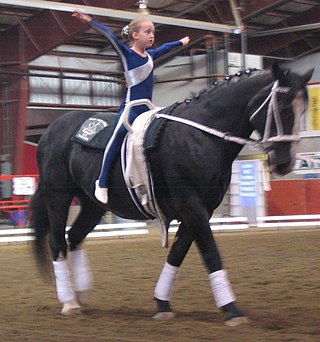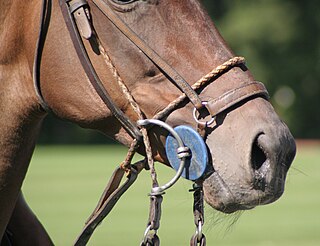Reins are items of horse tack, used to direct a horse or another animal used for riding or driving.
Contents
Rein may also refer to:
Reins are items of horse tack, used to direct a horse or another animal used for riding or driving.
Rein may also refer to:
Tack is equipment or accessories equipped on horses and other equines in the course of their use as domesticated animals. This equipment includes such items as saddles, stirrups, bridles, halters, reins, bits, and harnesses. Equipping a horse is often referred to as tacking up, and involves putting the tack equipment on the horse. A room to store such equipment, usually near or in a stable, is a tack room.

Equitation is the art or practice of horse riding or horsemanship.
Stan or STAN may refer to:
Theodore may refer to:

A bridle is a piece of equipment used to direct a horse. As defined in the Oxford English Dictionary, the "bridle" includes both the headstall that holds a bit that goes in the mouth of a horse, and the reins that are attached to the bit. It provides additional control and communication through rein pressure.
Stanhope may refer to:
Tonga is a Pacific Island nation whose people are known as Tongans.

Western pleasure is a western style competition at horse shows that evaluates horses on manners and suitability of the horse for a relaxed and slow but collected gait cadence, along with calm and responsive disposition. The horse is to appear to be a "pleasure" to ride, smooth-moving and very comfortable. Most light horse breeds in the United States and Canada may compete in western pleasure classes, either in open competition or at shows limited to a single breed. However, horse conformation and temperament play a role in this event, and hence animals of stock horse breeds that are calm, quiet, have collected, soft gaits and the strong muscling required to sustain slow, controlled movement are the most competitive.

A pelham bit is a type of bit used when riding a horse. It has elements of both a curb bit and a snaffle bit. In this respect a pelham bit functions similar to a double bridle, and like a double bridle it normally has "double" reins: a set of curb reins and a set of snaffle reins. Because it has a bit shank and can exert curb-style pressure on the horse, it is considered a curb bit. Like all curb bits, a pelham bit has a mouthpiece, shanks with both purchase and lever arms, a ring for rein attachment at the bottom of the shank, and a curb chain. But like a snaffle bit, a pelham bit also has a bit ring on either side of the mouthpiece. Like some curb bits, a pelham bit usually has "loose" shanks - hinged at the mouthpiece in the same way that the rings of a snaffle bit are hinged. When two sets of reins are used, the snaffle rein generally is wider, to help distinguish it from the curb. A "cowboy pelham" is a western style of loose-jawed curb bit with additional rings at the mouthpiece allowing a second set of reins to be added.

A curb bit is a type of bit used for riding horses that uses lever action. It includes the pelham bit and the Weymouth curb along with the traditional "curb bit" used mainly by Western riders.

A double bridle, also called a full bridle or Weymouth bridle, is a bridle that has two bits and four reins. One bit is the bradoon, is a modified snaffle bit that is smaller in diameter and has smaller bit rings than a traditional snaffle, and it is adjusted so that it sits above and behind the other bit, a curb bit. Another term for this combination of curb and snaffle bit is a "bit and bradoon", where the word "bit" in this particular context refers to the curb.

Side reins are equipment used when longeing a horse, running from the bit of the bridle to the saddle or surcingle. As a horse training tool, they encourage flexion and softness in the horse's mouth. For longe line work with a rider up who does not carry ordinary riding reins, they help calm and settle the animal. However, they are a tool best used by experienced handlers; used improperly they may unduly restrict the horse's movement or cause an accident.

The gag bit is a type of bit for a horse. Because the cheek piece and reins attach to different rings there is leverage action. Severity of leverage action depends on where the reins attach. For example, in a Dutch Gag, the further the rein attachment from the mouthpiece the greater the leverage. The gag bit is related to a Pelham bit and a double bridle but the gag bit has no curb strap.

Reins are items of horse tack, used to direct a horse or other animal used for riding. They are long straps that can be made of leather, nylon, metal, or other materials, and attach to a bridle via either its bit or its noseband.
Abdullah may refer to:
Draw reins and running reins are pieces of riding equipment used for training that use the mechanical advantage of a 'single movable pulley' to cause the horse to bring its head down and inward. While a regular rein is the strap that attaches to the bit and is held by the rider, these types of reins slide through the bit ring, adding leverage to the rider's hands and arms, allowing the rider to force the horse's head into a desired position.

Western riding is considered a style of horse riding which has evolved from the ranching and welfare traditions which were brought to the Americas by the Spanish Conquistadors, as well as both equipment and riding style which evolved to meet the working needs of the cowboy in the American West. At the time, American cowboys had to work long hours in the saddle and often over rough terrain, sometimes having to rope a cattle using a lariat, also known as a lasso. Because of the necessity to control the horse with one hand and use a lariat with the other, western horses were trained to neck rein, that is, to change direction with light pressure of a rein against the horse's neck. Horses were also trained to exercise a certain degree of independence in using their natural instincts to follow the movements of a cow, thus a riding style developed that emphasized a deep, secure seat, and training methods encouraged a horse to be responsive on very light rein contact.
Honour is the quality of being honorable.
A bitting rig or bitting harness is a training tool for horses that can teach a horse to accept a bridle and bit, and later assist a horse in developing the necessary musculature for a given equestrianism discipline. Generally used in conjunction with training on a longe line, it is most often seen in the training of Saddle seat horses, but also is used by some dressage trainers and as a tool to start horses in driving.

A bitless bridle is a general term describing a wide range of headgear for horses or other animals that controls the animal without using a bit. Direction control may also be via a noseband or cavesson, if one is used. The term hackamore is the most historically accurate word for most common forms of bitless headgear. However, some modern bitless designs of horse headgear lack the heavy noseband of a true hackamore and instead use straps that tighten around a horse's head to apply pressure in various ways. These are often specifically patented and marketed as "bitless bridles", usually referencing a particular type of headgear known as the cross-under, though other designs are sometimes also given similar names.